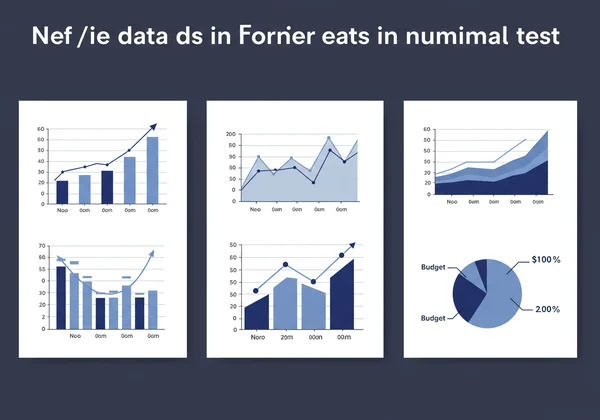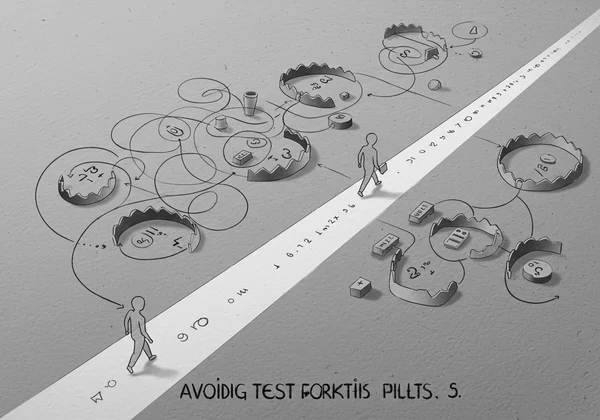แบบทดสอบความถนัดทางตัวเลข: คู่มือฝึกฝนฉบับสมบูรณ์
รู้สึกกังวลกับการทดสอบตัวเลขเพื่อสมัครงานที่กำลังจะมาถึงใช่ไหม? คุณไม่ได้อยู่คนเดียว ผู้สมัครหลายคนพบว่าการทดสอบเหล่านี้เป็นเรื่องที่น่ากลัว แต่เป็นทักษะที่คุณสามารถฝึกฝนให้เชี่ยวชาญได้ คำถามสำคัญคือ ฉันจะเตรียมตัวสำหรับการทดสอบความถนัดได้อย่างไร? คู่มือฉบับสมบูรณ์นี้จะอธิบายทุกสิ่งที่คุณจำเป็นต้องรู้เกี่ยวกับการทดสอบความถนัดเชิงตัวเลข ตั้งแต่ประเภทของคำถามที่คุณจะต้องเจอ ไปจนถึงกลยุทธ์ทีละขั้นตอนและตัวอย่างการฝึกฝน ด้วยหลักการทางจิตวิทยาและข้อเสนอแนะจากผู้สมัครหลายพันคน คู่มือนี้จะมอบกลยุทธ์ที่ใช้งานได้จริงให้คุณ เป้าหมายของเราคือการเพิ่มความมั่นใจและช่วยให้คุณได้คะแนนตามที่ต้องการ ขั้นตอนแรกในการปรับปรุงคือการทำความเข้าใจระดับปัจจุบันของคุณ ซึ่งคุณสามารถทำได้ด้วย แบบทดสอบอาชีพฟรี ของเรา
มาเปลี่ยนความกังวลในการสอบให้เป็นแผนปฏิบัติการที่มั่นใจกันเถอะ เมื่ออ่านจบ คุณจะเข้าใจไม่เพียงแค่สิ่งที่จะเจอ แต่ยังรวมถึงวิธีการเข้าถึงปัญหาแต่ละข้อด้วยความคิดที่ชัดเจน สงบ และมีกลยุทธ์
แบบทดสอบความถนัดเชิงตัวเลขคืออะไรกันแน่?
แบบทดสอบความถนัดเชิงตัวเลขคือการประเมินมาตรฐานที่นายจ้างใช้เพื่อประเมินความสามารถของผู้สมัครในการตีความ วิเคราะห์ และสรุปผลเชิงตรรกะจากข้อมูลตัวเลข ไม่เหมือนกับการทดสอบคณิตศาสตร์บริสุทธิ์ที่ประเมินความรู้ของคุณเกี่ยวกับสูตรที่ซับซ้อน แบบทดสอบความถนัดประเภทนี้จะวัดความสามารถในการนำไปใช้จริงในการทำงานกับตัวเลขตามที่พบในบริบทการทำงาน การทดสอบเหล่านี้เกือบทั้งหมดจะมีการจับเวลา ซึ่งเพิ่มองค์ประกอบของความกดดันที่วัดประสิทธิภาพและทักษะการตัดสินใจของคุณ

การประเมินนี้เป็นส่วนสำคัญของกระบวนการคัดกรองก่อนการจ้างงานหลายขั้นตอน โดยเฉพาะอย่างยิ่งสำหรับตำแหน่งงานในด้านการเงิน การให้คำปรึกษา การจัดการ และการวิเคราะห์ข้อมูล นายจ้างใช้เพื่อคาดการณ์ประสิทธิภาพของคุณในงานที่ต้องใช้การคิดเชิงปริมาณและการตัดสินใจโดยอาศัยข้อมูล คะแนนที่ดีบ่งบอกว่าคุณเป็นผู้สมัครที่มีความสามารถและมีไหวพริบในการวิเคราะห์
ทำความเข้าใจรูปแบบคำถามที่แตกต่างกัน
คำถามมักจะนำเสนอในรูปแบบปรนัยและอ้างอิงจากข้อมูลที่ให้มาในตาราง แผนภูมิ และกราฟ คุณอาจถูกขอให้คำนวณการเพิ่มขึ้นเป็นเปอร์เซ็นต์ ตีความแนวโน้ม หรือกำหนดอัตราส่วนจากชุดข้อมูล บริบทมักจะเกี่ยวข้องกับธุรกิจ เช่น การวิเคราะห์ตัวเลขยอดขาย แนวโน้มตลาด หรือการจัดสรรงบประมาณ การทำความคุ้นเคยกับรูปแบบเหล่านี้ผ่าน แบบทดสอบความถนัดออนไลน์ เป็นวิธีที่ดีเยี่ยมในการเตรียมตัว
ทำไมนายจ้างถึงใช้การประเมินที่อ้างอิงคณิตศาสตร์เหล่านี้
นายจ้างพึ่งพาการทดสอบเหล่านี้ด้วยเหตุผลที่ง่ายดาย: พวกมันเป็นตัวบ่งชี้ประสิทธิภาพการทำงานที่เชื่อถือได้ ในโลกที่ขับเคลื่อนด้วยข้อมูลในปัจจุบัน พนักงานทุกระดับจำเป็นต้องคุ้นเคยกับตัวเลข การประเมินเหล่านี้ให้การวัดความรู้ความเข้าใจด้านตัวเลขและทักษะการแก้ปัญหาของผู้สมัครที่เป็นกลาง ขจัดอคติส่วนตัวออกจากกระบวนการคัดกรองเบื้องต้น พวกมันช่วยให้บริษัทระบุบุคคลที่สามารถเข้าใจข้อมูลที่ซับซ้อนและมีส่วนร่วมในการตัดสินใจทางธุรกิจที่ดี
แตกต่างจากการสอบคณิตศาสตร์มาตรฐานอย่างไร
ความแตกต่างที่ใหญ่ที่สุดอยู่ที่การประยุกต์ใช้กับทฤษฎี การสอบคณิตศาสตร์มาตรฐานจะทดสอบความรู้ของคุณเกี่ยวกับแนวคิดและสูตรทางคณิตศาสตร์ที่เป็นนามธรรม อย่างไรก็ตาม แบบทดสอบความถนัดเชิงตัวเลขจะประเมินความสามารถของคุณในการประยุกต์ใช้หลักการทางคณิตศาสตร์พื้นฐาน—เช่น เปอร์เซ็นต์ อัตราส่วน และค่าเฉลี่ย—เพื่อตีความข้อมูลและแก้ปัญหาที่สมจริง มันไม่ได้เกี่ยวกับความรู้แคลคูลัสขั้นสูงมากนัก แต่เป็นเรื่องของทักษะในการตีความข้อมูลและการอนุมานเชิงตรรกะภายใต้ข้อจำกัดด้านเวลา
ทักษะสำคัญสำหรับการทดสอบความสามารถเชิงตัวเลขของคุณ
ในการประสบความสำเร็จในการทดสอบความสามารถเชิงตัวเลข คุณไม่จำเป็นต้องเป็นอัจฉริยะทางคณิตศาสตร์ แต่คุณต้องฝึกฝนชุดทักษะเฉพาะที่ช่วยให้คุณทำงานได้อย่างรวดเร็วและแม่นยำ การมุ่งเน้นการฝึกฝนในด้านหลักเหล่านี้จะนำมาซึ่งการพัฒนาประสิทธิภาพของคุณมากที่สุด ทักษะเหล่านี้เป็นรากฐานของแบบทดสอบความถนัดเพื่อประเมินอาชีพที่ดี
การตีความข้อมูลจากตารางและแผนภูมิ
นี่คือทักษะพื้นฐาน คุณจะได้รับข้อมูลที่แสดงผลในรูปแบบต่างๆ เช่น แผนภูมิแท่ง กราฟเส้น แผนภูมิวงกลม และตารางที่ซับซ้อน งานของคุณคือการค้นหาข้อมูลที่เกี่ยวข้องอย่างรวดเร็ว ทำความเข้าใจว่าแกนและป้ายกำกับแสดงถึงอะไร และใช้ข้อมูลนั้นเพื่อตอบคำถามเฉพาะ ทักษะนี้ทดสอบทั้งความใส่ใจในรายละเอียดและความสามารถในการสังเคราะห์ข้อมูลภาพของคุณ

การเชี่ยวชาญเปอร์เซ็นต์ อัตราส่วน และค่าเฉลี่ย
คำถามการคิดเชิงตัวเลขส่วนใหญ่มักจะเกี่ยวข้องกับแนวคิดทางคณิตศาสตร์หลักๆ ไม่กี่อย่าง คุณต้องคุ้นเคยกับการคำนวณการเปลี่ยนแปลงเปอร์เซ็นต์ การทำงานกับอัตราส่วนและสัดส่วน และการหาค่าเฉลี่ยหรือค่าเฉลี่ยถ่วงน้ำหนัก แม้ว่าการคำนวณเองมักจะง่าย แต่ความท้าทายคือการทำได้อย่างรวดเร็วและแม่นยำภายใต้ความกดดัน ความเร็วและความแม่นยำในพื้นฐานการคิดเชิงปริมาณเหล่านี้เป็นสิ่งที่ไม่สามารถต่อรองได้
การระบุแนวโน้มและการอนุมาน
นอกเหนือจากการคำนวณง่ายๆ แล้ว การทดสอบเหล่านี้ยังประเมินความสามารถของคุณในการอนุมานเชิงตรรกะ ซึ่งเกี่ยวข้องกับการระบุรูปแบบ การสังเกตแนวโน้มของข้อมูลเมื่อเวลาผ่านไป และการคาดการณ์ความเป็นไปได้ในอนาคตจากข้อมูลที่ให้มา ตัวอย่างเช่น คุณอาจถูกขอให้คาดการณ์ยอดขายไตรมาสถัดไปโดยอิงจากผลการดำเนินงานของปีที่แล้วที่แสดงในกราฟ ทักษะนี้แสดงให้เห็นถึงระดับการคิดวิเคราะห์ที่สูงขึ้นซึ่งนายจ้างให้ความสำคัญอย่างมาก การทำ แบบทดสอบความถนัดในการทำงาน สามารถช่วยให้คุณเห็นว่าด้านใดที่ต้องปรับปรุงเพิ่มเติม
กลยุทธ์สู่ความสำเร็จสำหรับการฝึกฝนแบบทดสอบความถนัด
การรู้ว่าการทดสอบเกี่ยวข้องกับอะไรเป็นเพียงครึ่งหนึ่งของชัยชนะ การฝึกฝนแบบทดสอบความถนัดที่มีประสิทธิภาพต้องใช้วิธีการที่เป็นระบบ กลยุทธ์สี่ขั้นตอนต่อไปนี้จะช่วยให้คุณเตรียมตัวได้อย่างมีประสิทธิภาพ สร้างความมั่นใจ และเพิ่มคะแนนของคุณในวันสอบ
ขั้นตอนที่ 1: วิเคราะห์คำถามอย่างรอบคอบ
ความกดดันจากการจับเวลามักทำให้ผู้สมัครรีบร้อนและอ่านคำถามผิดพลาด นี่เป็นข้อผิดพลาดที่สำคัญ ก่อนที่จะเริ่มพิจารณาข้อมูล ให้อ่านคำถามสองครั้งเพื่อให้แน่ใจว่าคุณเข้าใจสิ่งที่ถามอย่างถ่องแท้ คุณกำลังถูกถามหาเปอร์เซ็นต์การเพิ่มขึ้นหรือค่าสัมบูรณ์? คำตอบต้องเป็นหน่วยล้านหรือพัน? การขีดเส้นใต้ส่วนสำคัญของคำถามสามารถช่วยให้คุณมุ่งเน้นไปที่เป้าหมายได้
ขั้นตอนที่ 2: เชี่ยวชาญเทคนิคการบริหารเวลา
แบบทดสอบความถนัดเชิงตัวเลขคือการแข่งขันกับเวลา กลยุทธ์ทั่วไปคือการคำนวณเวลาเฉลี่ยที่คุณมีต่อคำถาม (เช่น 60-90 วินาที) และพยายามยึดติดกับเวลานั้น หากคุณติดอยู่กับคำถาม ให้เดาอย่างมีเหตุผล ทำเครื่องหมายไว้ แล้วไปต่อ การตอบคำถามที่ถูกต้องได้มากขึ้นดีกว่าการเสียเวลาหลายนาทีกับปัญหาที่ยากเพียงข้อเดียว การฝึกฝนทักษะนี้ให้สมบูรณ์แบบมักจะต้องทำ แบบทดสอบก่อนการจ้างงาน จำลอง

ขั้นตอนที่ 3: ใช้คำถามฝึกฝนฟรีของเรา
ไม่มีอะไรมาแทนที่การฝึกฝนได้ การฝึกทำคำถามที่สมจริงช่วยให้คุณคุ้นเคยกับรูปแบบ ปรับปรุงความเร็ว และระบุจุดอ่อนของคุณ เรามีแบบทดสอบความถนัดฟรีที่ออกแบบมาพร้อมคำถามที่สะท้อนสิ่งที่คุณจะเห็นในการประเมินจริง
นี่คือตัวอย่างการทำงานสั้นๆ:
- ข้อมูล: ตารางแสดงรายได้ของบริษัท 500,000 ดอลลาร์ ในปีที่ 1 และ 650,000 ดอลลาร์ ในปีที่ 2
- คำถาม: รายได้เพิ่มขึ้นกี่เปอร์เซ็นต์จากปีที่ 1 ถึงปีที่ 2?
- วิธีแก้:
- หาผลต่าง: 650,000 ดอลลาร์ - 500,000 ดอลลาร์ = 150,000 ดอลลาร์
- หารผลต่างด้วยจำนวนเริ่มต้น: 150,000 ดอลลาร์ / 500,000 ดอลลาร์ = 0.3
- แปลงเป็นเปอร์เซ็นต์: 0.3 * 100 = 30%
- คำตอบที่ถูกต้องคือเพิ่มขึ้น 30%
ขั้นตอนที่ 4: ทบทวนข้อผิดพลาดเพื่อการเรียนรู้
เพียงแค่ทำข้อสอบฝึกหัดไม่เพียงพอ คุณต้องเรียนรู้จากข้อผิดพลาดของคุณ หลังจากการฝึกฝนแต่ละครั้ง ให้ทบทวนทุกคำถามที่คุณตอบผิดอย่างละเอียด พยายามทำความเข้าใจว่าทำไมคุณถึงทำผิดพลาด เป็นข้อผิดพลาดในการคำนวณหรือไม่? คุณอ่านกราฟผิดหรือเปล่า? หรือคุณเข้าใจคำถามผิด? กระบวนการสะท้อนกลับนี้คือที่ที่การเรียนรู้ที่แท้จริงเกิดขึ้น และเป็นกุญแจสำคัญในการพัฒนาทักษะการรับรู้ของคุณ
การหลีกเลี่ยงข้อผิดพลาดทั่วไปในการทดสอบความถนัดทางคณิตศาสตร์
แม้แต่ผู้สมัครที่เตรียมตัวมาอย่างดีก็สามารถตกหลุมพรางทั่วไปได้ การตระหนักถึงข้อผิดพลาดเหล่านี้เป็นขั้นตอนแรกในการหลีกเลี่ยง การรับรู้ถึงสิ่งเหล่านี้จะช่วยให้คุณผ่านการทดสอบความถนัดทางคณิตศาสตร์ได้สำเร็จมากยิ่งขึ้น

การอ่านข้อมูลหรือคำถามผิด
นี่คือข้อผิดพลาดที่พบบ่อยที่สุดและน่าหงุดหงิดที่สุด ภายใต้ความกดดัน เป็นเรื่องง่ายที่จะดูคอลัมน์ผิดในตาราง หรือตีความหน่วยบนแกนแผนภูมิผิด (เช่น อ่านเป็นพันแทนที่จะเป็นล้าน) ตรวจสอบให้แน่ใจเสมอว่าคุณกำลังดึงข้อมูลที่ถูกต้องและคุณเข้าใจอย่างถ่องแท้ว่าคำถามกำลังถามถึงอะไรก่อนที่คุณจะเริ่มคำนวณ
การติดอยู่กับปัญหาที่ยากเพียงข้อเดียว
เวลาเป็นทรัพยากรที่มีค่าที่สุดของคุณในการทดสอบความถนัด เป็นความผิดพลาดทั่วไปที่จะติดอยู่กับคำถามที่ยากอย่างดื้อรั้น โดยมุ่งมั่นที่จะแก้ปัญหานั้น สิ่งนี้อาจทำให้คุณพลาดโอกาสในการตอบคำถามที่ง่ายกว่าหลายข้อในภายหลัง เรียนรู้ที่จะตระหนักว่าเมื่อใดที่ปัญหาใช้เวลานานเกินไป ให้เดาให้ดีที่สุดแล้วไปต่อ คุณสามารถกลับมาทำได้เสมอหากคุณมีเวลาเหลือในตอนท้าย
ข้อผิดพลาดจากการคำนวณพื้นฐานภายใต้ความกดดัน
เมื่อนาฬิกาเดินไปเรื่อยๆ สมองของคุณอาจเล่นตลกกับคุณได้ ข้อผิดพลาดจากการคำนวณพื้นฐานพบได้บ่อยอย่างน่าประหลาดใจ หากเป็นไปได้ ให้ใช้เครื่องคิดเลขที่จัดเตรียมไว้สำหรับการคำนวณทั้งหมด ยกเว้นการคำนวณพื้นฐานที่สุด นอกจากนี้ ควรอ่านตัวเลขที่คุณพิมพ์ลงในเครื่องคิดเลขซ้ำอีกครั้งอย่างรวดเร็วเพื่อให้แน่ใจว่าไม่มีข้อผิดพลาดในการพิมพ์ การใส่ใจเล็กน้อยในจุดนี้สามารถป้องกันข้อผิดพลาดที่มีค่าใช้จ่ายสูงได้ การค้นพบศักยภาพในการเกิดข้อผิดพลาดเหล่านี้เป็นประโยชน์จากการทำ แบบทดสอบอาชีพ ของเรา
พร้อมที่จะสร้างความมั่นใจด้านตัวเลขของคุณแล้วยัง?
การเชี่ยวชาญแบบทดสอบความถนัดเชิงตัวเลขไม่ใช่ความท้าทายที่เอาชนะไม่ได้ เป็นทักษะที่เรียนรู้ได้ซึ่งคุณสามารถพัฒนาได้ด้วยวิธีการที่ถูกต้อง ด้วยการทำความเข้าใจรูปแบบการทดสอบ การฝึกฝนทักษะสำคัญ การนำกลยุทธ์ที่มีประสิทธิภาพมาใช้ และการฝึกฝนอย่างสม่ำเสมอ คุณสามารถเปลี่ยนแหล่งความกังวลให้เป็นการแสดงความสามารถในการวิเคราะห์ของคุณได้ โปรดจำไว้ว่าการเตรียมตัวเป็นกุญแจสำคัญสู่ความมั่นใจ
คุณพร้อมที่จะทดสอบทักษะและปลดล็อกศักยภาพของคุณแล้วหรือยัง? เริ่มต้นด้วยแบบทดสอบความถนัดฟรีของเราตอนนี้ เพื่อรับผลลัพธ์ทันทีและรายงาน AI โดยละเอียดเกี่ยวกับจุดแข็งและจุดอ่อนของคุณ นี่คือก้าวแรกสู่การทำข้อสอบครั้งต่อไปของคุณให้ได้คะแนนดีเยี่ยม
คำถามที่พบบ่อยเกี่ยวกับแบบทดสอบตัวเลข
แบบทดสอบความถนัดเชิงตัวเลขยากไหม?
ความยากของแบบทดสอบความถนัดเชิงตัวเลขเป็นเรื่องส่วนบุคคลและขึ้นอยู่กับพื้นฐานและการเตรียมตัวของคุณ สำหรับผู้ที่ไม่คุ้นเคยกับการทำงานกับข้อมูลภายใต้ความกดดัน อาจรู้สึกท้าทาย อย่างไรก็ตาม คณิตศาสตร์พื้นฐานมักจะไม่ซับซ้อน ความยากเกิดจากข้อจำกัดด้านเวลาและความจำเป็นในการตีความข้อมูลอย่างรวดเร็วและแม่นยำ การฝึกฝนอย่างสม่ำเสมอจะช่วยลดความยากที่รับรู้ได้อย่างมาก
ฉันจะผ่านแบบทดสอบความถนัดได้อย่างไร?
การผ่านแบบทดสอบความถนัดคือการทำคะแนนให้สูงกว่าเกณฑ์ที่นายจ้างกำหนด ในการทำเช่นนี้ ให้มุ่งเน้นที่แผนการเตรียมตัวที่เป็นระบบ: 1) ทำความเข้าใจรูปแบบ 2) ทบทวนทักษะคณิตศาสตร์หลัก (เปอร์เซ็นต์ อัตราส่วน) 3) ฝึกฝนอย่างกว้างขวางภายใต้เงื่อนไขการจับเวลา และ 4) วิเคราะห์ข้อผิดพลาดของคุณเพื่อระบุและแก้ไขจุดอ่อน การใช้เครื่องมือฝึกฝนคุณภาพสูง เช่น แบบทดสอบออนไลน์ ของเราเป็นหนึ่งในกลยุทธ์ที่มีประสิทธิภาพที่สุด
คำถามความถนัดเชิงตัวเลขพื้นฐานคืออะไร?
คำถามพื้นฐานมักจะเกี่ยวข้องกับการอ่านแผนภูมิหรือตารางง่ายๆ และการคำนวณเพียงขั้นตอนเดียว ตัวอย่างเช่น คุณอาจได้รับแผนภูมิวงกลมแสดงงบประมาณของบริษัท และถูกขอให้คำนวณมูลค่าทางการเงินที่แน่นอนของส่วนงานเฉพาะนั้น คำถามพื้นฐานอื่นๆ รวมถึงการคำนวณความแตกต่างเป็นเปอร์เซ็นต์ระหว่างสองค่า หรือการหาค่าเฉลี่ยของชุดตัวเลข คำถามพื้นฐานเหล่านี้จะทดสอบทักษะเชิงตัวเลขหลักของคุณ